Skip to content
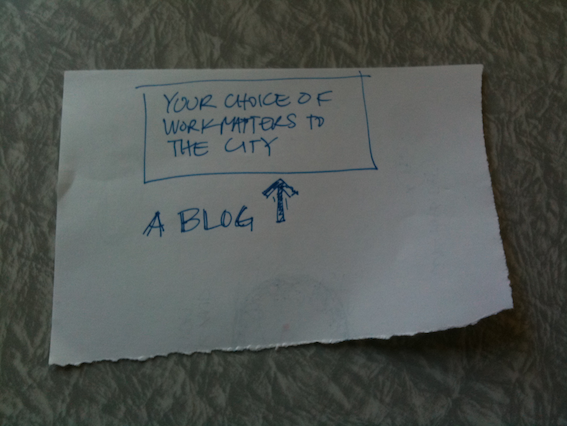
This note to myself has been sitting on the side of my desk for a while, waiting for the right time to act on it. Now that my immediate tasks as Co-Designer, Interviewer and Harvester for the Integral City 2.0 Conference are looked after, I can refocus on my writing here.
The last month has been gruelling. Every Tuesday, Wednesday and Thursday in the month of September explored one of the 12 evolutionary intelligences of the human hive, as identified by Marilyn Hamilton. I co-designed the program of over 50 visionaries whose work makes the world a better place, many of whom I had the opportunity to interview. My other role was to catch the story of each day and grasp the essence of each intelligence and the conference as a whole.
This window into the growing planet-wide community of thinkers, designers and practitioners confirms my belief that our work is the life force of our cities, whether we realize it or not. Our work, and our approach to our work, is what releases our true potential IF that work is aligned with what we wish to offer the world. The more our being is aligned with what we do, our work, the more our cities meet our needs.
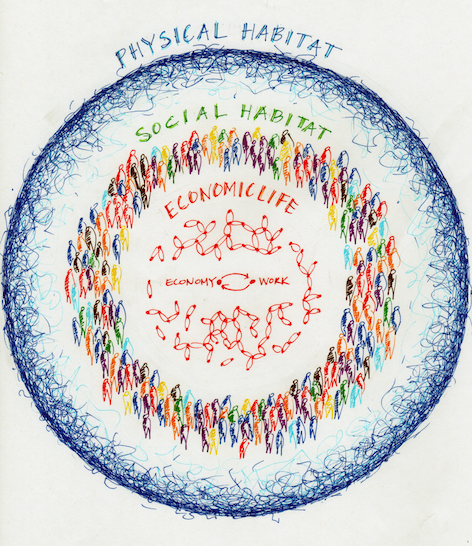
My September experience compels me to revisit many of my posts since my declaration in April to blog my book, Nest City: The Human Drive to Thrive in Cities. So far, I have shared three chapters with you: 1 – The City Impulse, 2 – The Planning Impulse, and 3 – The Thriving Impulse (click here for a recap). They paint a picture of how cities come about and the nature of our evolutionary relationship with cities.
Over the next few months my attention will be focused in two directions:
- Behind the scenes, I will be turning these first three chapters into their own publication that I will share with all readers as soon as it is complete.
- On this blog stage, I will share Part 2 of Nest City, focusing on how we can effectively organize ourselves in cities by taking into account our destination, the journey and the emergence of ourselves and our cities.
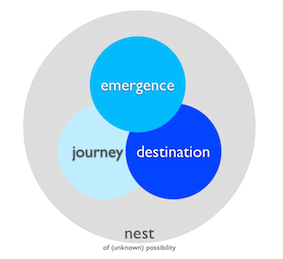
My Integral City 2.0 Online Conference expedition has fed my desire to dig deeper into our relationship with the cities we create.
My next post will revive the plot for of the city’s new story: organizing for emergence.
A reminder that my posts are not appearing here on Tuesdays, Wednesdays and Thursdays in September. My writing attention for these days is going to the Integral City Expo and eLab, where I am providing a written harvest for each day of the conference.
I realized last week that this is a paying gig to write about what I am passionate about – our evolutionary relationship with cities. It’s not lucrative, but there is a transaction. I write and I will be paid. I write and it will be read. Even better – I get to have a front row seat on what’s happening, even be the interviewer for 7 sessions.
This is a marathon endeavour for the month of September and it is a thrill. The Integral City Expo involves 50 visionary speakers in 36 sessions over 12 days. Each day focuses on one of the 12 evolutionary intelligences of cities. I am tired at the end of day 2, and I have yet to write today’s harvest.
Go to this link to register and listen to the 30 remaining sessions live as part of the Expo. For a small fee, you can get MP3 downloads and my take on each day’s intelligence.
Tomorrow’s focus is Living Systems Intelligence, with an opening session with Elisabet Sahtouris.
Earlier this week, in Writing from the red chair, I relayed how I have found a bench along Edmonton’s river valley on which to sit and write. The view is fantastic:
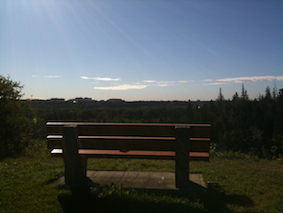
As I sit here I can hear the city and nature as well. In the bottom of the valley, slightly to the left, I can see the river flowing through the city. I feel the air float by and I can hear bird’s wings as they fly overhead.
Yesterday was a wet day in contract to today’s sun, but the power of sitting here at the edge of the city right in the middle of the city is remarkable. It is as though the city just wants to tell me all about itself.
When I first came upon this bench I stepped in front of it to enjoy the view and very briefly read the inscription placed on it.
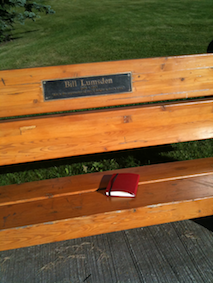
When I finished doing some morning stretching exercised (ITP Kata) and a little meditation on the edge of the bench, I sat in it and talked to myself. I sorted out that I needed to be able to write here, not just talk. I resolved to get a notebook a I stood up and prepared to leave. Then I realized that I had read the inscription on the bench incorrectly.
Here is what it says:
Art is the expression of man’s delight in God’s work.
I thought it said:
Art is the expression of God’s delight in man’s work.
The game my mind played with the words made this little message jump out at me. I have been musing about how I create the conditions for my creative self to flow freely. It may or may not be ‘art’ per se, but that doesn’t matter. It doesn’t matter if I believe in God, a higher power, a Spirit, a Creator or the creative Essence of my Self. These words are powerful.
Art is the expression of our delight in the world.
Art is the expression of our world’s delight in us.
The words are attributed to Bill Lumsden, 1928-1997. I have neighbours with the surname Lumsden, and while I have no idea if they are related, I can’t imagine that they are not. I felt as though my very neighbourhood was speaking to me, asking me to look at things and look again. Take the meaning of something and see if there is even more meaning.
And take great delight in what I find.
And share what I find for your delight.
My home, my nest, is getting an overhaul. And it has a hole in its roof. The truth is, we put the hole in on purpose, which is a little counter intuitive. But we have our reasons.
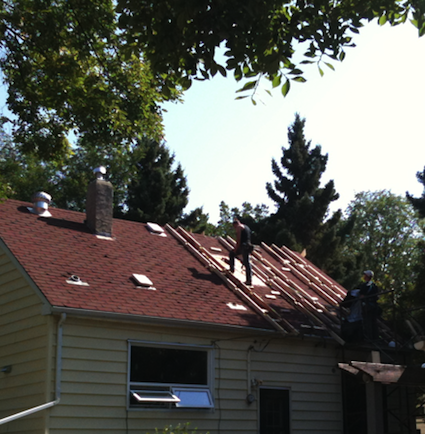
Our home is a post-war building with very little insulation, and little or no ventilation, so we are installing a new roof on top of the old roof to improve the building’s ability to keep itself and it’s occupants warm and dry.
We decided not to simply replace the shingles, for that only solves a portion of the building’s challenges. We have chosen to improve how the whole roof system works for the building. We decided not to build a whole new nest; we are making an investment in this one. She has lots to give us yet if we look after her.
So the whole in the roof…
There is a part of us that would love to make massive changes to the building. We realize that the space gained with an addition will not be needed in less than a decade (kids are 12 and 14). We also don’t have the strength to organize ourselves for a big reno. We also don’t wish to put our money in a big reno. But that doesn’t mean that we don’t want to treat ourselves. We chose a skylight to light up the stairwell and serve as a solar chimney on hot days. So our contractor cut a hole in the roof.
As we stood in the stairwell today, the kids and I looked through the roof out, over the neighbourhood, right through the fresh air. In the evening it is covered with a tarp, but as we move up and down the stairs we can hear the hum of the city. When it rained last night, it sounded like we were sleeping in our tent.
As I was falling asleep last night listening to the rain I realized that roof has an important job. For our species, we need to have somewhere warm and dry, our shelter, to survive. The very roof we choose to build on our shelters reflects our life conditions. Our home was built in a time when energy to heat homes was abundant and cheap. Energy is more scarce and more expensive and we are compelled to improve our building. Our context changes and we eventually change too, and our structures, our physical habitats, with us.
It took a hole in the roof for me to realize that the new roof is really about, at a family scale, fixing our nest, our family habitat. We are doing what we need to do to make sure the building functions well. We are also moving beyond pure function and sorting out as a family how we can ‘dress up’ the building so it conveys our style, our identity.
We have a chance to put our mark on our nest. As we come and go from our nest, we come and go from a place we have created for ourselves. A home can pull on the heart strings and we are choosing colours and materials that pull on our heart strings. We are also adding to the neighbourhood’s identity of itself. Collectively with our neighbours, we make our streets and neighbourhood. Everyone’s choices accumulate to a feeling about our place and our collective identity.
When we chose to put in a skylight, it felt gratuitous. But I am glad we put the hole in the roof.
Every time I travel the stairs I will be able to see the neighbourhood, the treetops and the stars from a new vantage point.
Every once and awhile city infrastructure needs a little help from its citizens.
We had a lot of rain and hail come down in a short amount of time this afternoon. Flights circled overhead as the storm blew threw. 23 manhole covers blew off. On my simple little street, the water filled the street and jumped the curb.
As Mother Nature cleaned her trees of leaves and twigs, the city’s infrastructure couldn’t let them through on its own. The leaves and twigs collected and blocked the water’s passage down the drain.

The city’s infrastructure needed some help. I had three choices:
- Do nothing.
- Call the City to fix it.
- See what I could do.
I chose the latter. I donned my rubber boots and raincoat and headed out the garage to find a helpful tool. (I have to chuckle that I was more excited than my kids about going out to muck about in a big puddle!) What fun! The water was aching to make its way down the drain. When I moved a wee bit of the blockage the drain sucked the water. Almost violently.

The city’s infrastructure was aching to do its work. It just needed a little assistance from a citizen to perform today. As I citizen, I often forget how closely linked my life is to the vast infrastructure we create, generation by generation, to create our city habitats. Our work has specialized to allow us not only to build, operate, maintain and renew this infrastructure. That is the work that some citizens do for cities, explicitly building the city.
Citizens who perform other kinds of work in cities are still closely connected to our infrastructure. Everything we do depends on it. And from time to time it needs very basic attention, for which no engineering expertise is required.
Sometimes the infrastructure system we have made for ourselves needs a little help from citizens. No expertise required.
_____ _____ _____
If interseted in the relationships between citizens, city infrastructure, and city decision-making, you may be interested in the Integral City Expo and eLab from Sept 4-27, 2012. I was the program co-designer and will be interviewing many of the 50 visionaries that will be participating.
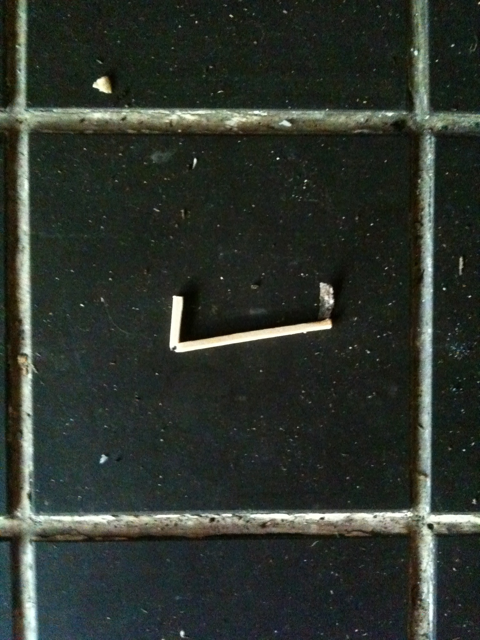
This little piece of wood is an error, despite its check-mark shape.
I came across this little piece of wood unexpectedly, in a place I should not have found it. It should not have been made like this. It should have been like its companions:
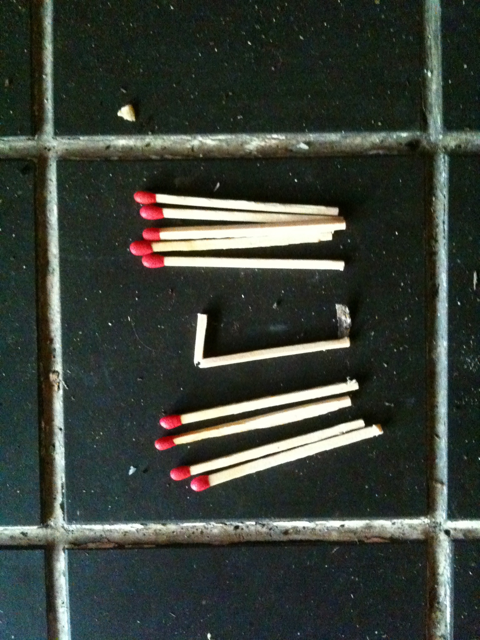
But somewhere in the manufacturing process, the error was made and the little piece of wood was lost, headless and bent among its mates.
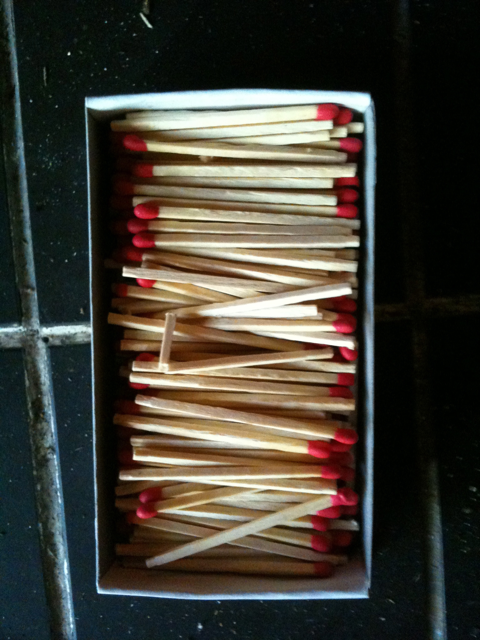
Sometimes, as we make our way through the world, we find ourselves looking a lot like everyone else, but yet fundamentally different. We fit in the box, but we are not built fundamentally for the same job as everyone else.
But being unable to do its particular job does not mean that our little piece of wood is not able to do other things. It may be the catalyst for fire in just the right place. It may be a shim to help something get to a new height.
We have no idea what a little piece of wood can do or be, just as we have no idea what each of us can do or be. We have no idea what power we can have. We usually have no idea what purpose each of us has, but we don’t need to know. We have a choice about what we wish to believe in, however.
This little piece of wood went into the fire, just as it was getting started. Along with the kindling and the wood, it played a role in getting the fire started in our fireplace this morning. The fire probably would have started without this one little piece of wood, but fire would not have lasted (safely) without wood. Each little piece has its place.
Each of us has our place, regardless of our shape or whether we appear to be fit for the job.
As citizens and cities, we have choices at every turn to create places and spaces for people to be everything they can be. Every citizen has her/his place. We don’t need to leave anyone lost and headless.
_____ _____ _____
Join me and my colleague Marilyn Hamilton as we host 50 visionaries in the Integral City 2.0 expo and eLab from September 4-27. We aim to reinvent the city.
In our city life, is the city the antagonist or citizens?
It’s hard to say. Consider this passage from Lynn Coady’s The Antagonist (p. 234-5):
I am starting to view my past in a different way these days. Strange to say under the circumstances, but I think now that I used to see my past as a book – a story with a beginning, middle, and end, all of which I knew by heart, and therefore had no reason to even crack the spine. But now I am starting to see it as something more like a frontier – a landscape I have spent my life cultivating, fortifying against the random elements. But the landscape is alive, is what I am realizing – is a thing unto itself – and if you’re brave enough to ever leave your house you start to see this. In fact, the landscape consists of multiple things, multiple wills that shift and change and occasionally assert themselves in force. None of this, you eventually understand, belongs to you – not a rock or flower a broken branch – no matter how you work it, no matter how much scrub you clear. The ground could decide to open up above your head.
The world is independent. It moves, and moves on, with or without you.
Everything, that is, except that which you make die. What you’ve killed is yours, forever – a trophy picked off from the landscape and hung up on your wall.
So you can greet one another each day.
The city, and city life, could be viewed as a story with a beginning, middle and an end. It could be a story with all three of these elements know (or thought to be known) or it could be a story that has started and we just don’t know the end yet. Just as the protagonist in The Antagonist, though, I too am starting to see city life as a frontier. City life both cultivates random elements and fortifies against random elements. City life is alive.
City live generates new conditions and problems to which we have to adjust. It causes us random elements. As the generation of new habitat causes us to adjust and innovate, this is the very skill we need to fortify against random elements. And as we do this work, endlessly because the story doesn’t have an ending that we can grasp, if there is one.
Just as the protagonist above, our city life consists of multiple things, multiple lives, multiple forces that ‘shift and change and occasionally assert themselves in force.’ As much as the city belongs to us and is created by us, it is not created by me. No matter how hard I work as an individual, ‘no matter how much scrub [i] clear,’ I do not have control over it. We create it and we can shape it. It may or may not work for me. Whether I am alive or dead, the city will move on with or without me.
What is clear to me, is that while I am in relationship with my city (from within or from afar), I do have control over what I keep from having a full life in cities. While this may appear to be a negative thing, it is crucial. I can choose, with every interaction I have with others, to allow the full potential for cities and citizens to emerge. I can help my city and citizens be fully alive, if they so choose.
Each of us have this decision – make things die or create the conditions for things to thrive.
When the city challenges us, it feels like the antagonist. This a crucial role, creating the challenges and tensions we need to grow. When we choose to make things die, we are the antagonist, for we keep citizens and the city from reaching their full potential.
I recognize that I can be the kind of antagonist that provides constructive tension. (Citizens create the very conditions that we have to respond to as a city!) I also recognize that I can be a destructive antagonist. When destructive, I aim to be conscious and see the trophy’s on my wall. I aim to see them and get to know them so that I may learn to serve myself, my fellow citizens and my city well.
I embrace the city and its challenges as a constructive antagonist in my (our) life (lives). The city creates the life conditions we and I need to grow and evolve. City life puts us on the frontier.
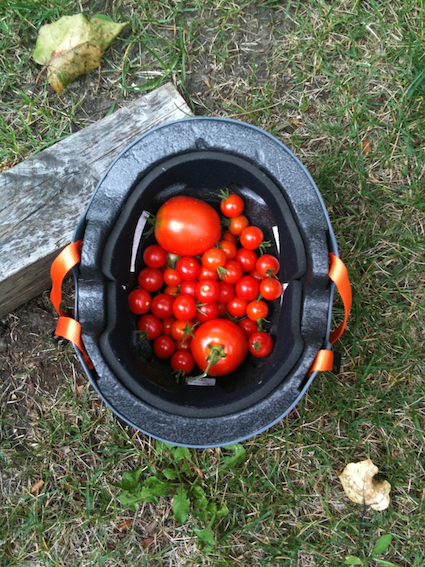 Thinking, making and doing new things can happen at any time. It just takes a change in perspective.
Thinking, making and doing new things can happen at any time. It just takes a change in perspective.
As I was heading back out to the lake yesterday from my home in the city, I had to stop in pick up bicycle helmets from the garage and harvest my garden’s tomatoes. The door to the house was locked so I didn’t have a bag or bowl for the tomatoes.
I was stopping at the garage on my way to the garden and I picked up my son’s helmet first. As it hung upside down on his handle bar, I could see the perfect bowl. So I went to the garden to harvest my tomatoes and put the helmet and tomatoes in the back of my car.
As I walked away from the garden, this logic struck me:
- The purpose of a helmet is to protect heads
- Heads are precious cargo
- Tomatoes are precious cargo
- While unconventional, it makes perfect sense to use a bicycle helmut to carry tomatoes
Believe it or not, this is an example of what makes a city tick.
Our economic life – our ability to generate new work – is t
he force that generates cities. The development of new work is fundamentally our ability to think, make and do new things. At heart is the ability to take something, say a bicycle helmet, and use it for a new purpose. Like flipping a helmet upside down to carry tomatoes instead of strapping it around a human head.
One of Jane Jacobs’ main ideas is that all new work takes place on the shoulders of existing work. New ways of
thinking, making and doing new things always use existing work. Just like using a helmet to carry tomatoes.
To grow cities that serve citizens well, we need to draw on the innovation that cities generate. To do this, we need to grow citizens that serve cities well. This requires a citizen practice where we remain open and curious to possibilities and potential.
We need to be forever looking for ways to make use of our helmets.
_____ _____ _____
Join me and 50 visionaries to re-envision the future of city at the City 2.0 EXPO, September 4-27, 2012. We are gathering leaders and city-zens the world over for an unprecedented – and free – virtual conference.
Join us to dream the future of the city.
I will be interviewing Brian Eddy and Michael Zimmerman on the opening day of the Integral City eLab, Tuesday September 4, 2012. We will be exploring ecosphere intelligence, our awareness and capacity to respond to a city’s climate and eco0region.
(For over a decade, Brian Eddy has been exploring sustainable development with an integral lens. Here is a link to one of his articles available online: Integral Geography: Space, Place and Perspective (2005 – World Future 61). Michael Zimmerman is author of Integral Ecology: Uniting Multiple Perspectives on the Natural World, a wonderful treatise on the the transdisciplinary nature of integral ecology.)
Day One will begin with Marilyn Hamilton’s interview of Bill Rees, author of Our Ecological Footprint, who will provide an overview of the contribution ecosphere intelligence makes to cities. Eddy and Zimmerman will zoom in on how the three principles of ecosphere intelligence can be used in city design:
- Honour the climate and geography of your city.
- Steward the environment.
- Add value to the earth space.
Day 1 will conclude with ecosphere intelligence practitioners Karen O’Brien and Ina Horlings, and a look at integral approaches to climate change and sustainability.
Click here for information on the eLab. Stay tuned for more information on the eLab and details on how to participate.
The Integral City eLab is taking place from September 4-27, 2012. Our mission – to pool curious minds to co-create an exploratory space for anyone wishing to create cities that serve citizens and cities well. We aim to create the conditions for a new, life-giving story for our cities, the habitat we create for ourselves to ensure we thrive.
eLab rooted in three principles
We have created the eLab because we believe that:
- Cities are the most relevant boundaries and crucibles for change
- For collaboration we need a common lens and language from which to communicate
- The city lens is under construction – it requires learning how to think differently
The purpose of the eLab is to create the conditions for these three principle to gain life, to change how we think about our cities. Our cities are a part of our evolutionary story and a significant part of the systems we humans build to support ourselves. It is time to understand city systems.
Here’s the skinny on the format
The eLab will take place over four weeks, three days each week for a total of 12 days. Each day of the eLab will explore one of the 12 evolutionary intelligences I have been exploring here and that form the basis of Marilyn Hamilton’s work (Integral City website, the book). The 12 intelligences are grouped in threes, giving each week an overal theme:
- Week 1 (Sep 4-7) – Planet of Cities
- Week 2 (Sep 11-13) – Gaia’s Reflective Organ
- Week 3 (Sep 18-20) – Aligning Strategies to Prosper
- Week 4 (Sep 25-27) – Amplifying Intelligence
Each day will explore one evolutionary intelligence through three questions and three principles that guide the intelligence. This will be done each day at three scales (three sessions each day): a thought leader, people who design for this intelligence and the stories of practitioners of the day’s intelligence.

Feel free to explore the eLab program further at your leisure. For details and registration please contact Marilyn Hamilton at marilyn@integralcity.ca
Over the next couple weeks I will be highlighting the speakers that will be sharing their work, life and stories about our relationships with our cities.
cheap football shirts |
cheap football shirts |
cheap football shirts |
cheap football shirts |
cheap football shirts |
cheap football shirts |
cheap football shirts |
cheap-football-shirts-prodirectsoccer |
cheap-football-shirts-discountfootballkits |
cheap-football-shirts-subsidesports |
cheap-football-shirts-uksoccershop |
cheap-football-shirts-mandmdirect |
cheap-football-shirts-mandmdirect-spot |
cheap-football-shirts-sportsdirect |
cheap-football-shirts-startfootball |
cheap-football-shirts-manutd |
cheap-football-shirts-directsoccer |
cheap-football-shirts-celticsuperstore |
cheap-football-shirts-classicfootballshirts |
cheap-football-shirts-prosocceruk |
cheap-football-shirts-kitking |
cheap-football-shirts-historicalkits |
cheap-football-shirts-teamsportdirect |
cheap-football-shirts-soccerkits |
windows 7 product key |
windows 7 key |
windows 7 product key |
Windows 7 Key ,
Windows 7 Key ,
Windows 8 Key ,
Windows 10 Key ,
Office 2013 Key ,
Office 2010 Key ,
Office 2016 Key ,
70-981 ,
700-501 ,
400-051 ,
200-310 ,
70-480 ,
642-999 ,
400-101 ,
ADM-201 ,
70-534 ,
400-101 ,
400-201 ,
599-01 ,
640-692 ,
640-875 ,
640-911 ,
642-997 ,
642-999 ,
700-037 ,
LX0-103 ,
70-347 ,
PR000041 ,
EX200 ,
640-692 ,
ITILFND ,
1z0-808 ,
300-208 ,
M70-201 ,
642-999 ,
icbb ,
n10-006 ,
pegacpba71v1 ,
70-533 ,
642-996 ,
102-400 ,
mb2-708 ,
070-483 ,
350-080 ,
A00-211 ,
1Z0-061 ,
70-486 ,
1z0-808 ,
ADM-201 ,
A00-211 ,
3002 ,
CBAP ,
1Z0-061 ,
640-911 ,
70-487 ,
3002 ,
MB5-705 ,
352-001 ,
70-346 ,
210-065 ,
M70-201 ,
070-483 ,
100-101 ,
642-035 ,
NS0-157 ,
EX300 ,
350-018 ,
A00-211 ,
PMP ,
642-996 ,
70-461 ,
IIA-CIA-PART1 ,
210-065 ,
300-101 ,
640-911 ,
OG0-093 ,
642-732 ,
642-035 ,
LX0-103 ,
pegacpba71v1 ,
500-260 ,
640-875 ,
mb2-708 ,
ex300 ,
c_tscm62_66 ,
1z0-060 ,
ns0-157 ,
2v0-621 ,
70-412 ,
400-201 ,
itilfnd ,
mb2-704 ,
1z0-804 ,
lx0-103 ,
210-060 ,
070-486 ,
a00-211 ,
cbap ,
300-320 ,
200-310 ,
642-999 ,
210-060 ,
101 ,
70-980 ,
300-208 ,
70-480 ,
hp0-s42 ,
1z0-804 ,
cca-500 ,
C2180-410 |
640-554 |
101 |
1V0-605 |
CCD-410 |
1Z0-061 |
HP0-S42 |
70-461 |
70-414 |
1Z0-062 |
74-678 |
CCD-410 |
1z0-432 |
C2070-991 |
200-120 |
74-697 |
300-101 |
70-534 |
70-243 |
M70-301 |
70-331 |
C2210-422 |
CCA-500 |
100-101 |
640-554 |
3002 |
1Z0-061 |
98-367 |
300-101 |
IIA-CIA-PART1 |
LX0-104 |
LX0-103 |
ITILFND |
352-001 |
MB2-708 |
PMP |
350-018 |
70-411 |
70-533 |
300-135 |
IIA-CIA-PART1 |
642-732 |
642-998 |
1Z0-804 |
C_TSCM62_66 |
101 |
PR000041 |
642-999 |
LX0-104 |
ICBB |
300-135 |
ITILFND |
200-310 |
640-875 |
SY0-401 |
1Z0-803 exam |
220-801 exam |
300-101 exam |
70-467 exam |
CISSP exam |
SY0-401 exam |









